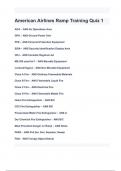Samenvatting
Anxiety and Related disorder (GGZ2024): Een complete en compacte samenvatting van de volledige stof.
- Instelling
- Maastricht University (UM)
Een hele beknopte samenvatting van alle stof; lectures, tasks, practicals, project works en literature. Deze samenvatting bezit alle highlights voor het tentamen van course 5: Anxiety and Related disorders. Het is een duidelijke samenvatting van de rode lijn van de stof. Heel handig om nog even lek...
[Meer zien]














